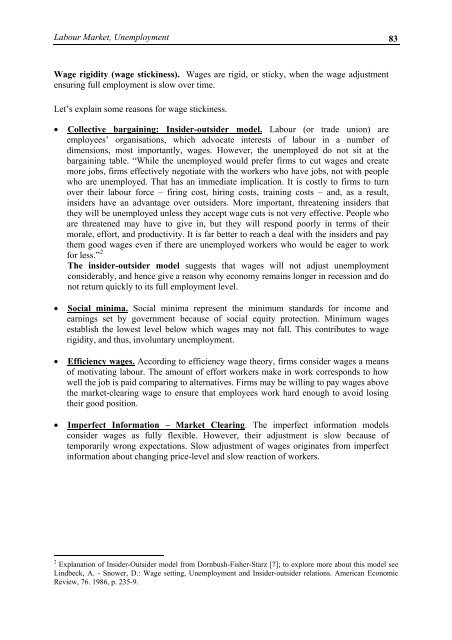MacroeconomicsI_working_version (1)
Create successful ePaper yourself
Turn your PDF publications into a flip-book with our unique Google optimized e-Paper software.
Labour Market, Unemployment 83<br />
Wage rigidity (wage stickiness). Wages are rigid, or sticky, when the wage adjustment<br />
ensuring full employment is slow over time.<br />
Let’s explain some reasons for wage stickiness.<br />
• Collective bargaining: Insider-outsider model. Labour (or trade union) are<br />
employees’ organisations, which advocate interests of labour in a number of<br />
dimensions, most importantly, wages. However, the unemployed do not sit at the<br />
bargaining table. “While the unemployed would prefer firms to cut wages and create<br />
more jobs, firms effectively negotiate with the workers who have jobs, not with people<br />
who are unemployed. That has an immediate implication. It is costly to firms to turn<br />
over their labour force – firing cost, hiring costs, training costs – and, as a result,<br />
insiders have an advantage over outsiders. More important, threatening insiders that<br />
they will be unemployed unless they accept wage cuts is not very effective. People who<br />
are threatened may have to give in, but they will respond poorly in terms of their<br />
morale, effort, and productivity. It is far better to reach a deal with the insiders and pay<br />
them good wages even if there are unemployed workers who would be eager to work<br />
for less.” 2<br />
The insider-outsider model suggests that wages will not adjust unemployment<br />
considerably, and hence give a reason why economy remains longer in recession and do<br />
not return quickly to its full employment level.<br />
• Social minima. Social minima represent the minimum standards for income and<br />
earnings set by government because of social equity protection. Minimum wages<br />
establish the lowest level below which wages may not fall. This contributes to wage<br />
rigidity, and thus, involuntary unemployment.<br />
• Efficiency wages. According to efficiency wage theory, firms consider wages a means<br />
of motivating labour. The amount of effort workers make in work corresponds to how<br />
well the job is paid comparing to alternatives. Firms may be willing to pay wages above<br />
the market-clearing wage to ensure that employees work hard enough to avoid losing<br />
their good position.<br />
• Imperfect Information – Market Clearing. The imperfect information models<br />
consider wages as fully flexible. However, their adjustment is slow because of<br />
temporarily wrong expectations. Slow adjustment of wages originates from imperfect<br />
information about changing price-level and slow reaction of workers.<br />
2 Explanation of Insider-Outsider model from Dornbush-Fisher-Starz [7]; to explore more about this model see<br />
Lindbeck, A. - Snower, D.: Wage setting, Unemployment and Insider-outsider relations. American Economic<br />
Review, 76. 1986, p. 235-9.




